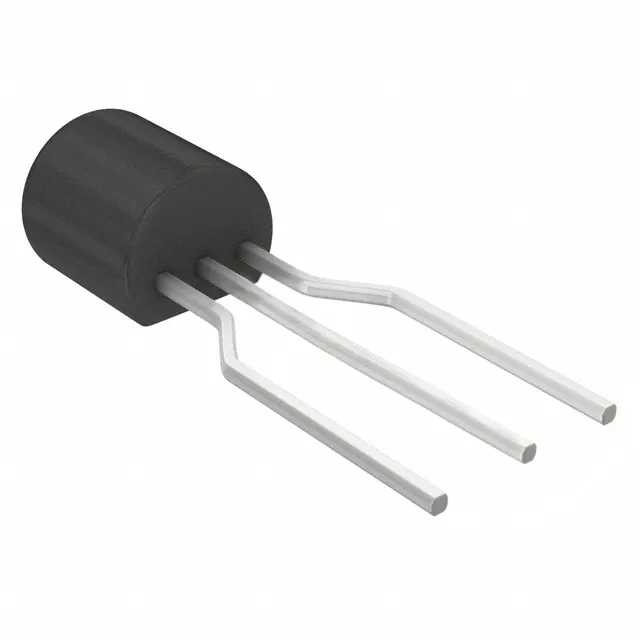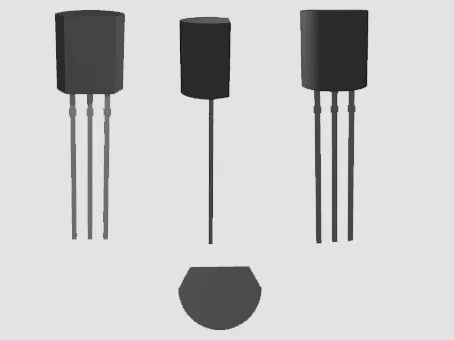2N5088 Transistor : Pinout, Equivalent, Datasheet

This NPN bipolar junction transistor (BJT) has a high gain and low noise profile, making it a popular choice for audio and high frequency applications. Circuits requiring low signal distortion and high gain can benefit from the 2N5088's superior performance characteristics. A comprehensive overview of the datasheet will be provided, explaining its key specifications and illustrating its application in electronic design as well as exploring pinout configuration, equivalent transistors, and the datasheet features.
What is the 2N5088 Transistor?
Designed for audio and high-frequency applications, the 2N5088 transistor provides high gain and low noise. In addition, it has a high gain of current (hFE) to enhance weak signals, which makes it highly efficient. In audio preamplifiers, radio frequency (RF) circuits, and other equipment requiring minimal signal distortion, the 2N5088 has a low noise figure. This enables it to be used in a wide range of electronic circuits due to its ability to handle relatively high currents and voltages.
The robustness and reliability of the 2N5088 go beyond its performance characteristics. Due to its TO-92 package, it can be easily handled and integrated into circuit designs, and it operates efficiently across a wide range of temperatures. Both hobbyists and professionals working on audio and RF projects use the 2N5088 because it's widely available and compatible with similar transistors. For maximizing the potential of the 2N5088 in electronic designs, it is essential to understand its pinout, equivalent transistors, and detailed specifications from its datasheet.
2N5088 CAD Model

Footprint

3D Models
2N5088 Features
High Gain
High current gains (hFE) are characteristic of 2N5088 transistors, which typically range from 300 to 900. Especially useful in audio and radio frequency (RF) applications, this high gain device amplifies weak signals very efficiently. Its high gain makes it an excellent choice for preamplifiers and signal processing circuits, as even very small input signals can be amplified to a usable level. In addition, high-fidelity audio systems can be designed with minimal distortion using the high gain characteristic.
Low Noise
Its low noise figure ensures minimal signal distortion and interference, which is one of the standout features of the 2N5088. Clarity and signal integrity are paramount in audio and RF applications with low noise performance. In order to preserve the purity of the audio signal, low noise transistors like the 2N5088 reduce hiss and other unwanted background noise. RF applications require low noise to maintain high communication quality and signal processing, as well as to ensure clean transmission and reception of signals.
High Frequency Response
RF applications requiring a high frequency response can take advantage of the 2N5088 transistor's high frequency response. The high-frequency capability makes it ideal for RF amplifiers, oscillators, and mixers because it can handle rapid signal changes without significant performance loss. In applications that require fast, accurate signal processing, the 2N5088 is highly versatile and effective.
Wide Range of Operating Temperatures
With a typical operating temperature range of -55°C to +150°C, the 2N5088 performs efficiently under a wide range of conditions. From consumer electronics to industrial applications, the 2N5088 is suitable for a wide range of operating temperatures. In addition to its versatility and dependability, this transistor is reliable in extreme temperatures, making it suitable for use in a variety of applications without sacrificing performance.
Robust Construction and Reliability
2N5088 is a rugged and reliable chip housed in a TO-92 package. Since TO-92 packages are compact and easy to handle, they are popular for small-signal transistors, enabling them to be incorporated into a variety of circuit designs. In both professional and hobbyist projects, the 2N5088 is trusted for its durability and long-term reliability. For a wide range of applications, the 2N5088 has proven to be a reliable performer and resistant to thermal and electrical stresses.
Versatility
This component is ideal for a variety of applications due to its high gain, low noise, high frequency response, and robust construction. Signal processing circuits, oscillators, mixers, audio amplifiers, and RF amplifiers use it. Providing high performance and reliability across a wide variety of electronic designs, the 2N5088 is versatile and can be used in various fields of electronic design. With its comprehensive feature set, the 2N5088 makes a valuable addition to any electronic toolkit, whether used in audio equipment, communication devices, or industrial electronics.
Fast Switching Speed
Due to its fast switching speeds, the 2N5088 transistor is suitable for use in digital and analog switching applications. Switching circuits require rapid transitions from on to off states, and its rapid response time makes this device ideal for such applications. High-speed digital applications such as pulse-width modulation (PWM) and signal modulation can benefit greatly from this fast switching capability. High-speed signal processing circuits benefit greatly from the 2N5088's ability to switch quickly and efficiently.
High Input Impedance
A circuit incorporating the 2N5088 has a low load on preceding stages due to its high input impedance. Signal strength is minimized and input signal integrity is maintained with high input impedance in amplification circuits. For microphone preamplifiers, which have sensitive input stages, 2N5088 is an excellent choice due to its fidelity. A wide variety of signal sources can be efficiently interfaced with the 2N5088 because of its high input impedance.
Applications
Audio Preamplifiers
A 2N5088 transistor's high gain characteristics and low noise make it a highly popular component in audio preamplifiers. An audio preamplifier needs components with the ability to amplify weak audio signals, such as those produced by microphones or other low-level sources. This is where the 2N5088 excels, amplification that preserves the original audio's fidelity while providing clear, accurate amplification. As a result of its low noise figure, the amplified audio will remain clean and free from unwanted background hiss, making it the perfect choice for high-fidelity audio systems, recording equipment, and sound reinforcement systems.
Radio Frequency (RF) Amplifiers
The 2N5088 delivers a low level of noise and a high frequency response in RF applications. RF amplifiers amplify high-frequency signals and improve the transmission and reception quality of communication devices such as radios and transmitters. Several hundred megahertz is the frequency range that the 2N5088 is designed to handle, making it a perfect fit for such applications. This transmitter produces clear and reliable communication signals due to its high gain and low noise figure.
Oscillators and Signal Generators
Furthermore, the 2N5088 is suitable for manufacturing oscillators and signal generators requiring high frequencies. Many electronic devices use oscillators to generate periodic signals, such as clocks, timers, and waveform generators. 2N5088 oscillator circuits are stable and accurate due to their high gain and frequency response. In test and measurement equipment, communication systems, and digital electronics, these characteristics ensure that generated signals are precise and consistent.
Switches and Digital Circuits
There is a need for rapid changes in state in digital switching circuits, which is where 2N5088s are used. They provide rapid state changes due to their high switching speeds. A logic gate is a gate that opens and closes according to a set of instructions. A flip-flop is another type of logic gate. Designed for high-speed digital applications, the 2N5088 is capable of switching quickly without significant delay. Digital electronics rely on its reliable switching performance to ensure correct and efficient operation of digital circuits.
Communication Devices
Telephones, modems, and intercom systems use this transistor to amplify data and voice signals. To ensure effective communication, these devices must provide clear and reliable signal amplification. Providing the necessary amplification while maintaining signal integrity, the 2N5088 provides the necessary amplification due to its low noise and high gain characteristics. In order for communication devices to operate smoothly and efficiently, they must be reliable and perform consistently.
Sensor Signal Amplifiers
Various types of sensors generate small signals that the 2N5088 amplifies in sensor signal amplifiers. It is often necessary to amplify the weak signals generated by these sensors, such as temperature sensors, pressure sensors, light sensors, for further analysis. These small signals are amplified accurately by the 2N5088 due to its high gain and low noise features. Industrial automation, environmental monitoring, and instrumentation applications can all benefit from the 2N5088.
Final Thoughts
With its high versatility and reliability, the 2N5088 transistor can be used in a wide range of audio and high-frequency applications. Besides its high gain and low noise, this module also has a wide range of operation features that make it a favorite of both professionals and hobbyists. With its datasheet, you can learn how to use it effectively and efficiently in various electronic projects by understanding the pinout, equivalents, and detailed specifications.
2N5551 Transistor:Features,Applications and Pinout
D882 Transistor: Understanding Its Functionality
Tip41c: What Makes It a Reliable Power Transistor?
BC338 NPN Transistor: Features, Applications, and FAQ
What is the BC547 Transistor? Its Features & Applications
2N4401 NPN Transistor: Datasheet, Applications, and Features
2N3904S Transistor: Features, Applications, and Datasheet
BSN254A Transistor: Applications, Datasheet, and Equivalent
13009D Transistor: Applications, Equivalent and Specifications
2N2222 Transistor: Applications, Features, and Specifications
2SA733 Transistor: Applications, Features, and Specifications










